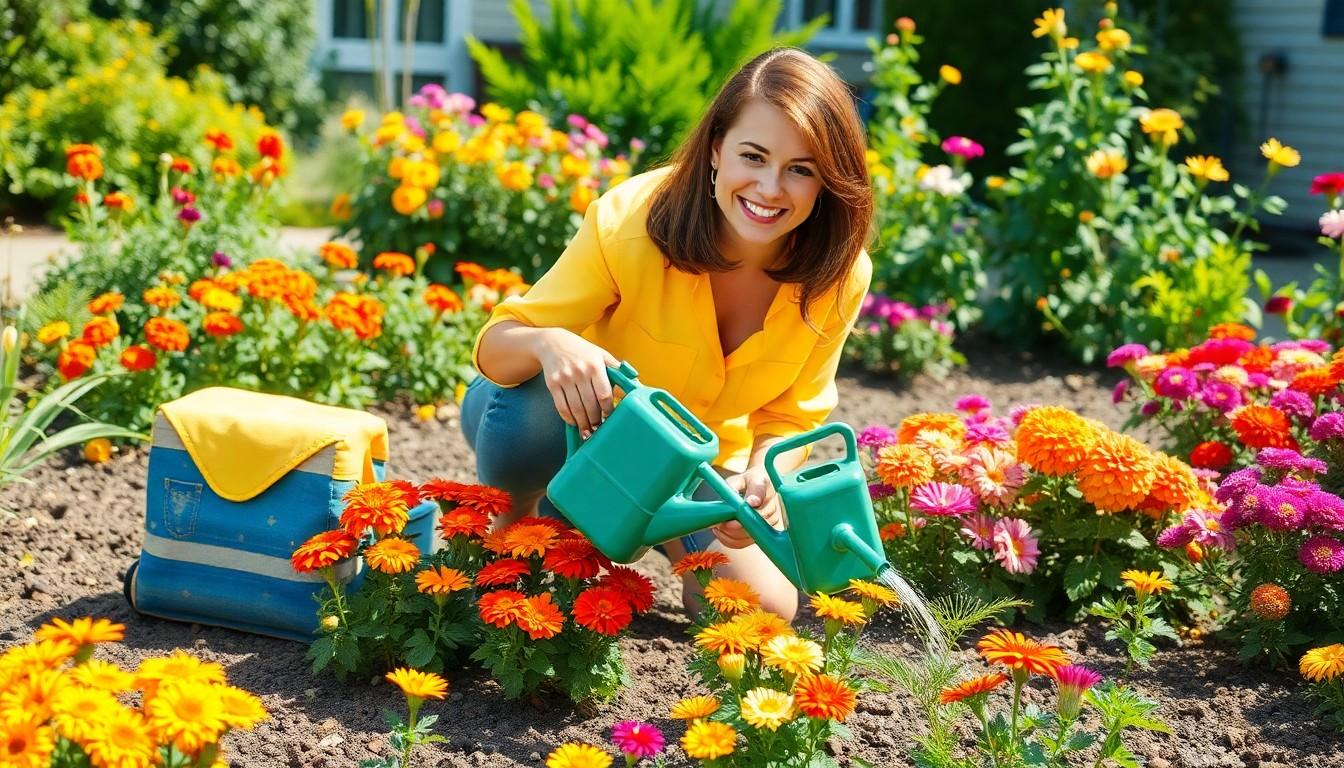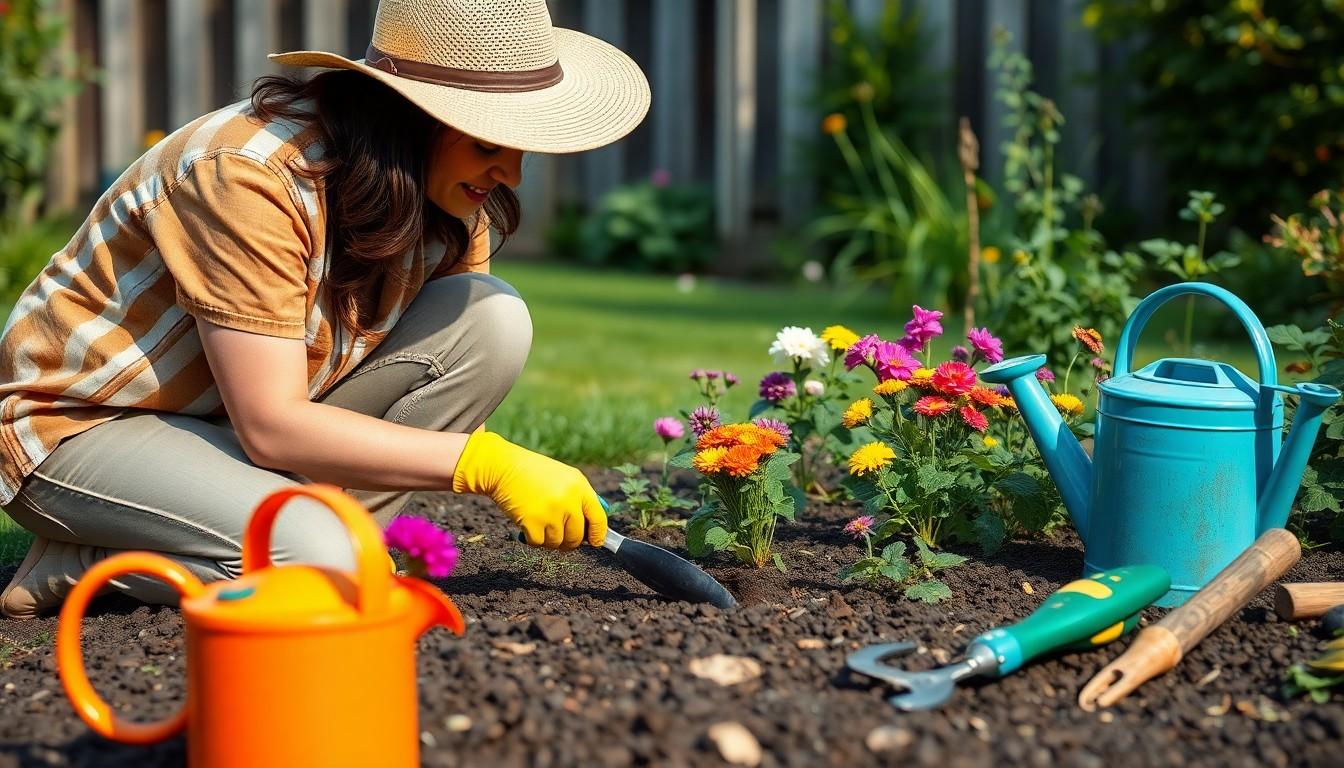Phone:
(701)814-6992
Physical address:
6296 Donnelly Plaza
Ratkeville, Bahamas.

Diving into flower gardening can feel like stepping into a vibrant world of color and fragrance. For beginners, it’s not just about planting seeds; it’s about cultivating joy and a little bit of dirt under those nails. Picture this: a sunny afternoon, a gentle breeze, and the sweet smell of blooms filling the air. Who wouldn’t want that?
Flower gardening involves more than planting seeds. It’s about creating a vibrant space filled with color and fragrance. Beginners often start by selecting easy-to-grow flowers like marigolds, petunias, and zinnias. Understanding local growing conditions helps ensure success.
Choosing the right location plays a crucial role in gardening. Ideally, flowers need at least six hours of sunlight daily. Assessing soil quality becomes essential, as well-drained and fertile soil supports healthy growth. Beginners can consider adding organic compost for enriched nutrients.
Watering requires attention too. For many flowers, a deep watering once a week encourages deep root growth. Routine checks for pests and diseases aid in maintaining plant health. Early intervention often leads to better outcomes.
Timing also matters when planting. Spring is a popular season for starting annual flowers, while perennials can be planted in either spring or fall. Utilizing seed packets and planting guides provides useful information on planting depths and spacing.
Creating a gardening calendar enhances organization. Note the dates for planting, watering, and fertilizing. Many gardening apps and resources offer reminders and best practices tailored for specific flowers.
Experimentation fuels creativity. Trying different color combinations and flower arrangements allows beginners to personalize their gardens. Joining local gardening clubs or online forums fosters community support and knowledge sharing.
With patience and dedication, flower gardening becomes a rewarding hobby. Nurturing flowers can transform any space and bring immense joy. Each bloom serves as a testament to the gardener’s efforts, resulting in a thriving, beautiful landscape.

Successful flower gardening relies on having the right tools. Equipping oneself with essential tools makes the process easier and more enjoyable.
Choosing the right flowers ensures a vibrant garden that thrives. Beginners can explore effective options by focusing on the characteristics of annuals and perennials.
Annuals complete their life cycle within one growing season. Examples include marigolds, petunias, and zinnias. These flowers typically bloom profusely and add instant color to gardens. Perennials, on the other hand, return year after year, such as coneflowers and daylilies. They may take longer to establish but offer enduring beauty and often require less maintenance over time. Understanding this difference helps beginners decide based on planned efforts and desired visual impact. Mixing both types enhances the overall garden experience by combining vibrant bursts of color with lasting blooms.
Local climate significantly impacts flower gardening success. Regions with warm summers and mild winters benefit from a wide variety of flowering plants. For instance, sunflowers thrive in sunny environments, while pansies prefer cooler temperatures. Assessing hardiness zones provides insight into which flowers to select. They indicate which plants can withstand specific weather conditions. Additionally, understanding microclimates within a garden space helps in choosing appropriate flowers. Sheltered areas may retain warmth, providing opportunities for less hardy plants. Adjusting flower selection based on climate leads to healthier blooms and more rewarding gardening experiences.
Preparing the garden bed sets the foundation for a successful flower garden. Attention to soil quality and layout greatly impacts plant growth and overall aesthetics.
Testing soil provides insights into its pH level and nutrient content. A home testing kit or local extension service can offer guidance. Most garden flowers thrive in slightly acidic to neutral pH, around 6.0 to 7.0. Once the results are known, amending soil with organic matter, like compost, improves fertility and drainage. Adding lime or sulfur can adjust pH as needed. Consider mixing in slow-release fertilizers to boost nutrient availability, ensuring a healthy start for flowers.
Planning the garden layout creates a visually appealing space. Position taller flowers at the back of the bed and shorter ones at the front to enhance visibility. Group flowers by color or type for an organized appearance. Include pathways for easy access to the plants, ensuring maintenance is manageable. Consider the sunlight requirements of each flower when choosing locations, placing sun-loving varieties where they’ll receive maximum exposure. Arranging flowers in clusters can create impactful bursts of color, adding depth and interest.
Successful flower gardening relies on effective planting and care practices. To promote healthy growth, beginners must understand watering and fertilization techniques.
Watering regularly keeps flowers healthy and vibrant. It’s important to water early in the morning or late in the afternoon to minimize evaporation. Each flower type has unique moisture needs; check specific requirements to avoid over or under-watering. Soil should remain moist, not soggy. A layer of mulch can help retain moisture and reduce weed growth. Observing plants provides valuable insights; drooping or yellowing leaves often signal the need for water. Adjust watering frequency during dry spells, ensuring flowers receive enough hydration.
Fertilizing supports flower growth and enhances blooms. Select a balanced, slow-release fertilizer, applying according to manufacturer instructions. Timing is essential; fertilize at the start of the growing season or when planting for optimal results. Organic options like compost or well-rotted manure improve soil quality while providing nutrients. Regularly assess the condition of plants to determine if additional fertilization is necessary. Avoid over-fertilizing, which can lead to excessive foliage with fewer blooms. Each feeding boosts the garden’s vibrancy, promoting a stunning display of color and beauty.
Beginners often face various challenges in flower gardening. Addressing these issues leads to a more rewarding experience.
Maintaining a thriving flower garden requires effective pest management. Familiarity with common pests like aphids and slugs aids in quick identification. Implementing natural deterrents such as neem oil or insecticidal soap ensures minimal chemical use. Regularly inspecting plants helps catch infestations early. Encouraging beneficial insects like ladybugs or lacewings can naturally reduce pests. Crop rotation and companion planting enhance resistance to pests. Understanding each flower’s vulnerabilities allows for targeted strategies. These methods collectively create a healthier garden environment.
Weather fluctuations present significant challenges for flower gardening. Protecting tender plants from frost by covering them with cloth or using row covers proves essential in colder months. During hot spells, providing shade or consistent watering prevents stress. Monitoring local forecasts helps anticipate extreme weather events. Grouping plants with similar water and sunlight needs simplifies care during shifts in temperature. Mulching around plants retains soil moisture while regulating temperature fluctuations. Awareness of seasonal patterns influences planting times and flower selection. Adapting to weather conditions enhances overall garden resilience.
Flower gardening offers a fulfilling journey for beginners eager to cultivate beauty and joy. With the right tools and knowledge about local conditions, anyone can create a vibrant space filled with color and fragrance. Embracing the learning process and experimenting with different flowers can lead to stunning results and personal satisfaction.
Joining gardening communities can provide valuable support and encouragement along the way. As they nurture their gardens, beginners will discover the rewards of patience and dedication. Ultimately, each bloom serves as a reminder of their hard work and passion for gardening.